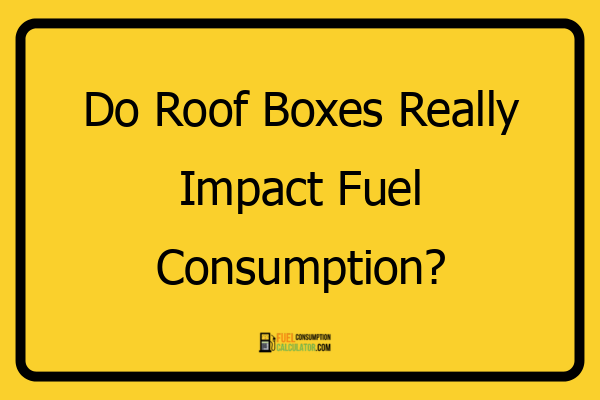When planning a road trip or outdoor adventure, many drivers consider using roof boxes for extra storage. However, a common concern arises: do roof boxes affect fuel consumption? Surprisingly, the answer is a resounding yes, and the impact can be more significant than you might think.
In this article, we’ll explore how roof boxes influence fuel efficiency, the factors at play, and what you can do to mitigate the effects on your gas mileage.
Contents
Key Takeaways
- Fuel Consumption Increase: Roof boxes can decrease fuel economy by 15-35%, depending on various factors like speed and weight.
- Aerodynamics Matter: The shape and design of the roof box significantly influence drag and fuel efficiency.
- Speed Sensitivity: The faster you drive, the more pronounced the negative impact on fuel consumption due to increased aerodynamic drag.
- Weight Considerations: While added weight does play a role, the primary factor affecting fuel economy is the change in aerodynamics.
- Practical Solutions: Removing roof boxes when not in use can help maintain better fuel efficiency.
Understanding Fuel Economy and Roof Boxes
Roof boxes are designed to provide additional storage space for gear and luggage, but they come with a cost. The primary way they affect fuel consumption is through increased aerodynamic drag.
When a vehicle travels at higher speeds, the wind resistance against the box increases significantly. For instance, tests have shown that removing factory crossbars from vehicles resulted in a 3 mpg improvement at highway speeds due to reduced drag.
Moreover, studies indicate that even an empty roof rack can negatively impact fuel economy by nearly 2%—equating to approximately three-quarters of a gallon of gas for every 100 miles driven. This means that if you’re frequently hitting the highway, those small percentages can add up quickly.
Factors Influencing Fuel Consumption
Aerodynamics
The design of your roof box plays a critical role in how it affects fuel efficiency. Aerodynamically shaped boxes create less drag compared to bulky or square designs. For example, streamlined models can minimize wind resistance and help maintain better mileage.
Speed
Speed is another crucial factor. At lower speeds (around 50 mph), the impact on fuel consumption is less noticeable than at higher speeds (70 mph or more). Research indicates that driving with a roof box at higher speeds can lead to a significant drop in miles per gallon (mpg), making it essential to consider your driving habits when using one.
Weight
While weight does contribute to decreased fuel efficiency, it is not as impactful as aerodynamic drag. The additional weight of a fully loaded roof box may slightly reduce mpg, but its effect pales compared to how much drag it creates at speed.
Real-World Examples
To illustrate these points, consider two scenarios:
- A driver using a Thule cargo basket reported a drop of 2-3 mpg after three months of use. They found that removing it for regular trips improved their mileage significantly.
- Another driver noted that their Kia Carnival improved by 3 mpg after removing factory crossbars during highway tests, highlighting how even small adjustments can lead to noticeable savings.
Practical Application
If you’re planning to use a roof box:
- Remove It When Not Needed: If you’re not using your roof box for an extended period, take it off to improve aerodynamics.
- Choose Wisely: Invest in an aerodynamically designed box to minimize drag.
- Monitor Your Speed: Try to keep speeds moderate when traveling with a roof box to reduce fuel consumption.
Conclusion
In summary, while roof boxes offer valuable storage solutions for travelers and adventurers alike, they do come with trade-offs in terms of fuel consumption. Understanding how factors like aerodynamics and speed affect your vehicle’s efficiency can help you make informed decisions about when and how to use these accessories. By taking proactive steps—like removing your roof box when it’s not in use—you can enjoy your adventures without sacrificing too much at the pump.
Citations:
[1] https://www.consumerreports.org/fuel-economy-efficiency/how-rooftop-carriers-affect-fuel-economy/
[2] https://www.reddit.com/r/Crosstrek/comments/11y3yng/for_anyone_with_the_roof_racks_does_it_negatively/
[3] https://www.caranddriver.com/news/a42596866/tested-roof-rails-affect-gas-mileage/
[4] https://www.subaruforester.org/threads/2023-how-much-impact-to-mpg-with-roof-top-box.842060/
[5] https://www.whichcar.com.au/car-advice/do-roof-racks-affect-fuel-efficiency
[6] https://forums.whirlpool.net.au/archive/30x1q0ry
[7] https://www.jegs.com/tech-articles/how-much-does-a-rooftop-carrier-affect-fuel-economy/
[8] https://support.roofbox.co.uk/hc/en-gb/articles/360021034000-How-will-a-roof-box-affect-fuel-economy

Hi, I’m Sufiyan, the developer behind this platform. I created FuelConsumptionCalculator.com to simplify fuel tracking for everyone — because understanding your vehicle shouldn’t require a degree in mechanics. I’m always working on adding more tools and content to make this site even more useful

